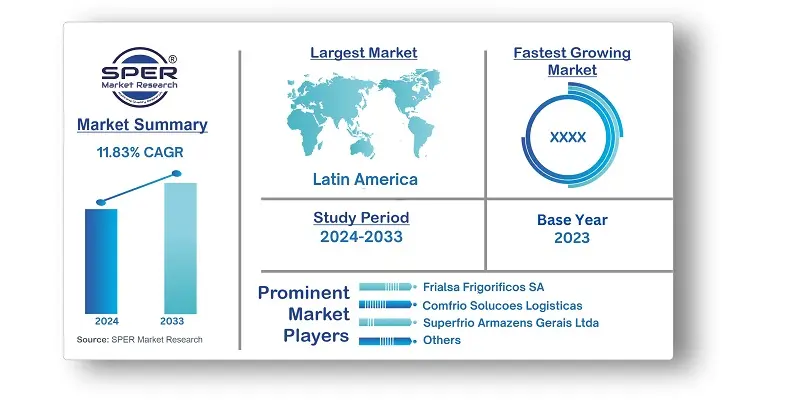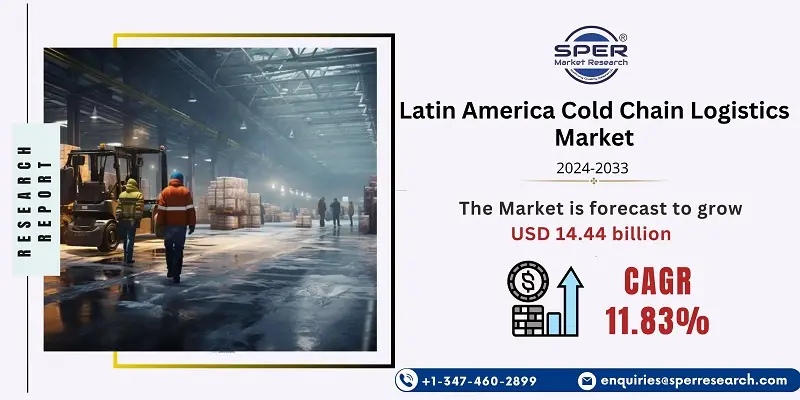
Latin America Cold Chain Logistics Market Growth, Size, Trends, Share, Revenue and Future Outlook
Latin America Cold Chain Logistics Market Size- By Service, By Temperature, By End User- Regional Outlook, Competitive Strategies and Segment Forecast to 2033
| Published: Jun-2024 | Report ID: AMIN24149 | Pages: 1 - 157 | Formats*: |
| Category : Automotive & Transportation | |||
- In June 2023, Canadian Pacific announced a strategic collaboration to co-host American storage facilities on the CPKC network. The goal is to build the first facility on CPKC's network in Kansas City (Mo.), Kansas, that will combine cold storage and added-value services with faster intermodal transport solutions Connects significant markets in the United States, Midwest, and Mexico.
- November 2022: Emergent Cold Latin America (Emergent Cold LatAm), the region's fastest-growing cold storage logistics business, announces the acquisition of a distribution centre in Recife, Brazil. The company has now made two investments in northeastern Brazil. The new Emergent Cold LatAm facility has a building size of more than 19,000 square metres and 18,500 pallet places for storage. It is perfectly located in Recife, one of Brazil's largest cities and the most important economic hub in the northeast.
- In October 2022, the fastest-growing refrigerated storage and logistics company in Latin America announced the expansion of its temperature-controlled facility in Panama City, Panama. The projected extension will add about 8,300 pallet positions to the facility, increasing its overall capacity to 28,300 pallets.


| Report Metric | Details |
| Market size available for years | 2020-2033 |
| Base year considered | 2023 |
| Forecast period | 2024-2033 |
| Segments covered | By Service, By Temperature, By End-User |
| Regions covered | Brazil, Mexico, Chile, Colombia, Peru |
| Companies Covered | Frialsa Frigorificos SA, Comfrio Solucoes Logisticas, Friozem Armazens Frigorificos Ltda, Superfrio Armazens Gerais Ltda, Americold Logistics, Brasfrigo, Arfrio Armazens Gerais Frigorificos, Ransa Comercial SA, Localfrio, Qualianz. |
- Pharmaceutical Companies
- Food and Beverage Manufacturers
- Retailers and Supermarkets
- Logistics Service Providers
- Healthcare Providers
- Agricultural Producers
- Government and Regulatory Bodies
- Technology Providers
- Cold Storage and Warehouse Operators
- Importers and Exporters
| By Service: |
|
| By Temperature: |
|
| By End User: |
|
- Latin America Cold Chain Logistics Market Size (FY’2024-FY’2033)
- Overview of Latin American Cold Chain Logistics Market
- Segmentation of Latin America Cold Chain Logistics Market by Service {Cold Storage/Refrigerated Warehousing, Refrigerated Transportation, Value-added Services (Order Management, Blast Freezing, Labeling, Inventory Management, etc.)}
- Segmentation of Latin America Cold Chain Logistics Market by Temperature (Chilled, Frozen, Ambient)
- Segmentation of Latin America Cold Chain Logistics Market by End User {Fruits and Vegetables, Dairy Products (Milk, Butter, Cheese, Ice Cream, etc.), Fish, Meat, and Seafood, Processed Food, Pharmaceutical (Includes Biopharma), Bakery and Confectionery, Other End Users}
- Statistical Snap of Latin America Cold Chain Logistics Market
- Expansion Analysis of Latin America Cold Chain Logistics Market
- Problems and Obstacles in Latin America Cold Chain Logistics Market
- Competitive Landscape in the Latin America Cold Chain Logistics Market
- Impact of COVID-19 and Demonetization on Latin America Cold Chain Logistics Market
- Details on Current Investment in Latin America Cold Chain Logistics Market
- Competitive Analysis of Latin America Cold Chain Logistics Market
- Prominent Players in the Latin America Cold Chain Logistics Market
- SWOT Analysis of Latin America Cold Chain Logistics Market
- Latin America Cold Chain Logistics Market Future Outlook and Projections (FY’2024-FY’2033)
- Recommendations from Analyst
1.1. Scope of the report1.2. Market segment analysis
2.1. Research data source2.1.1. Secondary Data2.1.2. Primary Data2.1.3. SPER’s internal database2.1.4. Premium insight from KOL’s2.2. Market size estimation2.2.1. Top-down and Bottom-up approach2.3. Data triangulation
4.1. Driver, Restraint, Opportunity and Challenges analysis4.1.1. Drivers4.1.2. Restraints4.1.3. Opportunities4.1.4. Challenges4.2. COVID-19 Impacts of the Latin America Cold Chain Logistics Market.
5.1. SWOT Analysis5.1.1. Strengths5.1.2. Weaknesses5.1.3. Opportunities5.1.4. Threats5.2. PESTEL Analysis5.2.1. Political Landscape5.2.2. Economic Landscape5.2.3. Social Landscape5.2.4. Technological Landscape5.2.5. Environmental Landscape5.2.6. Legal Landscape5.3. PORTER’s Five Forces5.3.1. Bargaining power of suppliers5.3.2. Bargaining power of buyers5.3.3. Threat of Substitute5.3.4. Threat of new entrant5.3.5. Competitive rivalry5.4. Heat Map Analysis
6.1. Latin America Cold Chain Logistics Market Manufacturing Base Distribution, Sales Area, Product Type6.2. Mergers & Acquisitions, Partnerships, Product Launch, and Collaboration in Latin America Cold Chain Logistics Market
7.1. Latin America Cold Chain Logistics Market Size, Share and Forecast, By Service, 2020-20267.2. Latin America Cold Chain Logistics Market Size, Share and Forecast, By Service, 2027-20337.3. Cold Storage/Refrigerated Warehousing7.4. Refrigerated Transportation7.5. Value-added Services (Order Management, Blast Freezing, Labeling, Inventory Management, etc.)
8.1. Latin America Cold Chain Logistics Market Size, Share and Forecast, By Temperature, 2020-20268.2. Latin America Cold Chain Logistics Market Size, Share and Forecast, By Temperature, 2027-20338.3. Chilled8.4. Frozen8.5. Ambien
9.1. Latin America Cold Chain Logistics Market Size, Share and Forecast, By End User, 2020-20269.2. Latin America Cold Chain Logistics Market Size, Share and Forecast, By End User, 2027-20339.3. Fruits and Vegetables9.4. Dairy Products (Milk, Butter, Cheese, Ice Cream, etc.)9.5. Fish, Meat, and Seafood9.6. Processed Food9.7. Pharmaceutical (Includes Biopharma)9.8. Bakery and Confectionery9.9. Other End Users
10.1. Latin America Cold Chain Logistics Size and Market Share
11.1. Latin America Cold Chain Logistics Market Size and Market Share By Region (2020-2026)11.2. Latin America Cold Chain Logistics Market Size and Market Share By Region (2027-2033)11.2.1. Brazil11.2.2. Mexico11.2.3. Chile11.2.4. Colombia11.2.5. Peru11.2.6. Others
12.1. Frialsa Frigorificos SA12.1.1. Company details12.1.2. Financial outlook12.1.3. Product summary12.1.4. Recent developments12.2. Comfrio Solucoes Logisticas12.2.1. Company details12.2.2. Financial outlook12.2.3. Product summary12.2.4. Recent developments12.3. Friozem Armazens Frigorificos Ltda12.3.1. Company details12.3.2. Financial outlook12.3.3. Product summary12.3.4. Recent developments12.4. Superfrio Armazens Gerais Ltda12.4.1. Company details12.4.2. Financial outlook12.4.3. Product summary12.4.4. Recent developments12.5. Americold Logistics12.5.1. Company details12.5.2. Financial outlook12.5.3. Product summary12.5.4. Recent developments12.6. Brasfrigo12.6.1. Company details12.6.2. Financial outlook12.6.3. Product summary12.6.4. Recent developments12.7. Arfrio Armazens Gerais Frigorificos12.7.1. Company details12.7.2. Financial outlook12.7.3. Product summary12.7.4. Recent developments12.8. Ransa Comercial SA12.8.1. Company details12.8.2. Financial outlook12.8.3. Product summary12.8.4. Recent developments12.9. Localfrio12.9.1. Company details12.9.2. Financial outlook12.9.3. Product summary12.9.4. Recent developments12.10. Qualianz12.10.1. Company details12.10.2. Financial outlook12.10.3. Product summary12.10.4. Recent developments12.11. Others
SPER Market Research’s methodology uses great emphasis on primary research to ensure that the market intelligence insights are up to date, reliable and accurate. Primary interviews are done with players involved in each phase of a supply chain to analyze the market forecasting. The secondary research method is used to help you fully understand how the future markets and the spending patterns look likes.
The report is based on in-depth qualitative and quantitative analysis of the Product Market. The quantitative analysis involves the application of various projection and sampling techniques. The qualitative analysis involves primary interviews, surveys, and vendor briefings. The data gathered as a result of these processes are validated through experts opinion. Our research methodology entails an ideal mixture of primary and secondary initiatives.



Frequently Asked Questions About This Report
PLACE AN ORDER
Year End Discount
Sample Report
Pre-Purchase Inquiry
NEED CUSTOMIZATION?
Request CustomizationCALL OR EMAIL US
100% Secure Payment






Related Reports
Our Global Clients
Our data-driven insights have influenced the strategy of 200+ reputed companies across the globe.




















